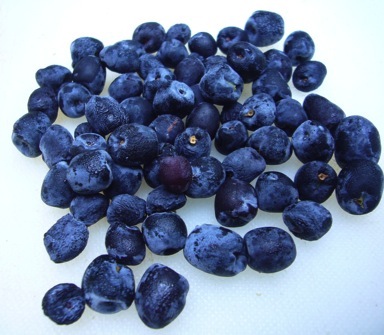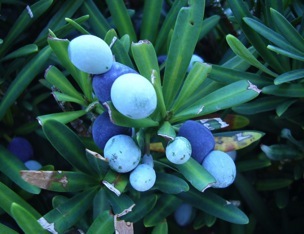Podocarpus: Your Own Hedge Fund
One can’t learn everything at once, and so I came to know the Podocarpus macrophyllus late in my foraging career.
There were very good reasons for this. A similar looking shrub planted locally has toxic fruit, and parts of the Podocarpus are toxic as well save for the aril. So it was one of those plants I knew about but put off for another day. And I did until a foraging friend, Marabou, got me interested in them again.
Like so many other things on the Internet that starts out as a “warning” on one site becomes “avoid” on another, “toxic” on a third and “deadly” by the fourth. It is truly unfortunate that every new medium of communication invented by man becomes a heap of nonsense. Most sites will tell you the fruits of the Podocarpus macrophyllus are toxic and avoid them. This is highly inaccurate. The plant and seed are toxic. The seed’s aril or “receptacle” is edible. That aril can ripen to red, blue or dark purple. The point is the fleshy aril pulp is edible raw or cooked. The seed is not edible. I also think that if one is going to eat a lot of them one also should not eat the core found in the aril. I suspect that in ripe fruit the core (stem) through the aril is the source of occasional reports of toxicity, particularly among children who eat a lot of them.
Podocarpus (pod-oh-KAR-pus) means “foot fruit” and macrophyllus (mak-roh-FIL-us) big leaved. The “foot fruit” is very similar to how cashews grow, seed on one end, fruit on the other. (Raw cashews by the way are toxic.) The strap-shaped leaves are skinny, and while much longer than wide, they are not greatly long, up to 3 inches. The tree is native to southern Japan and China. In Japan it is called Kusamaki or Inumaki. In China it is called Luo han song. It has at least eight names in English, best not used. Kusamaki can mean “grass plant” in Japanese, a reference perhaps to the leaves.
There are about 100 species in the genus, give or take a half dozen either way. The P. macrophyllus was introduced to the United States in the 1800s, probably before 1860, and no doubt no later than the Japanese Centennial exhibit in 1876 in which kudzu made its debut as well. In its native wild P. macrophyllus can grow to an 80-foot tree. Locally it is a landscape standard and escaped opportunist (it grows quickly from seed.) On a bike trail nearby there are two 40-foot Podocarpus trees. The P. macrophyllus with red fruit is usually the variation Maki.
While many authors say the fruity part is flavorless and slimy, I have found them to be sweet and juicy. They taste very much like blueberries to me, or perhaps red grapes minus the tartness though the texture is similar. But, not all palates agree. Locally they ripen around the end of July and the beginning of August, some years mid-August. Fruit left on the bush to dry have a texture similar to raisins with a hint of pine. Interestingly, the P. macrophyllus is related to the Nagi Tree which has an inedible blue fruit. The seed oil of the Nagi Tree is edible but not the seed itself or its covering.
Since the P. macrophyllum seed is not edible and must be separate from the aril, I have found the quickest and easiest way to do that is to twist the two parts apart, rolling one part one way, and the other part the other way. Keep the aril and throw away the seed. The wood is used in making furniture, paper, and farm tools
Green Deane’s “Itemized” Plant Profile
IDENTIFICATION: Erect, slim, evergreen shrub or tree with dark glossy green leaves with lighter underside. Two to four inches long, a quarter inch wide, tapering to a point, no veins except for prominent midrib. Attached in dense spirals. Fruit two parts, a fleshy receptacle then seed. Seed has blue sheen that rubs off to reveal a green seed. Receptacle can be blue to purple to red. Edible. The attached seed is NOT edible.
TIME OF YEAR: Fruits in summer, locally late July into August
ENVIRONMENT: Well-drained soil, but usually is found in landscaping. An extremely common hedge plant, found across the southern United States and up the west coast.
METHOD OF PREPARATION: Arils raw or cooked. Can be made into jelly, pies and the like. Seeds are not edible.




Great site. Is the podocarpus self-fruitful?
As far as I know, yes.
the one i have is. i may have the column-type.
i think my dad has only one podocarpus, too, and his is self-fruitful, too.
The scientific name can be understood in a more precise way. It means “pedunculate fruit”. I understand that other fruits from similar taxa are sessile. Podos is indeed the Greek word for “foot”, and corresponds to the Latin pes / pedis. Botanists have called pedunculus (“small foot”) the stem subtending the flower and the fruit.
plum pine, the podocarpus elatus tree here in australia, has an edible fleshy part also. it is tastes and looks like a red grape
It was great running across this article. I instantly recognized the fruit. I remember eating them when I was a kid. We had one of these bushes just outside our front porch. I used to eat the fruit whenever it was available. I don’t remember how I learned they were edible. I never knew the seeds were toxic though but I never ate them. The seeds were hard from what I remember and didn’t seem desirable to eat.
GreAt site. Thanks for info on 2 poocarpus
They keep them trimmed as hedges.
I have no idea what that comment is in reference too.
Did you mention the name of the look a like and how to tell apart? I know I’ve seen one of them but not sure which one? Thanks.
You should avoid yews.
Has anyone grown the dwarf variety? Is it good for fruit? Would love a dwarf hedge for the fruit.
Would the seeds, leaves and limbs be toxic to dogs?
Probably.
My podocarpus fruit is I light beige color (banana). Is the fruit edible? It’s about the size of a large olive.
Are you sure you have the right species?
Yes! I have the same fruit as Jim- NEVER seen it before on a podocarpus- we have the little blueberry looking things too- but the large round yellow fruit we’ve never had before- until this past month (Jan-Feb) They almost look like small loquats. Does anyone know if they’re edible?
Afrocarpus gracilior fruit. Is this edible?
Not that I know of. I have no reference to it.
I also have come across trees that I believe is about 40′ podacarpus with a beige colored slimy fruit all over the ground in S Ca. There are many trees both sides of the street
G’day. I have Podocarpus elatus and dispermus growing at my place in Bundaberg Australia. Both are native to Australia. I have just got my hands on macrophyllus – seedlings are very similar to elatus. Looking forward to seeing the fruit. Cheers.
I have grown one for years. Never flowered, never fruited. BOught another. Same. I think it needs more heat that we have up here in Portland, OR.
JOhn
I just read that only the female plant bares fruit. Maybe you have males.
Hi!
I am from south of Brazil and I am searching about the Podocarpus macrophyllus for a study I am making here.
What references do you used to these information? May you tell me if this plant (or their fruits) are toxics?
I really thank you!
Thanks for the great article! Are you able to provide any information on the nutrition profile of the fruit?
For example, are they rich in antioxidants? What vitamins and other micro nutrients do they contain?
Just bought a home, and quite happily and accidentally, there are several of these bushes bearing fruit in the front yard.